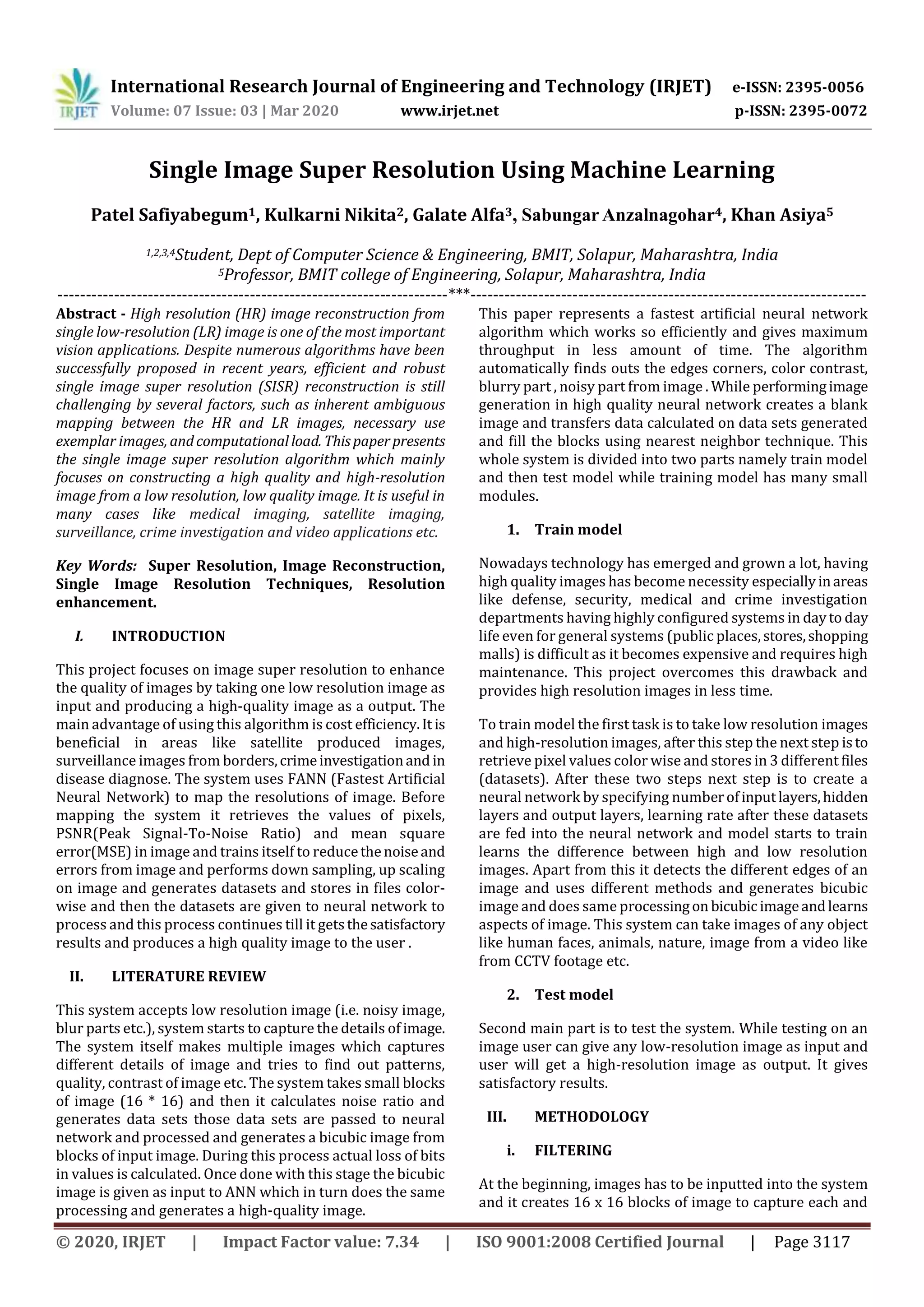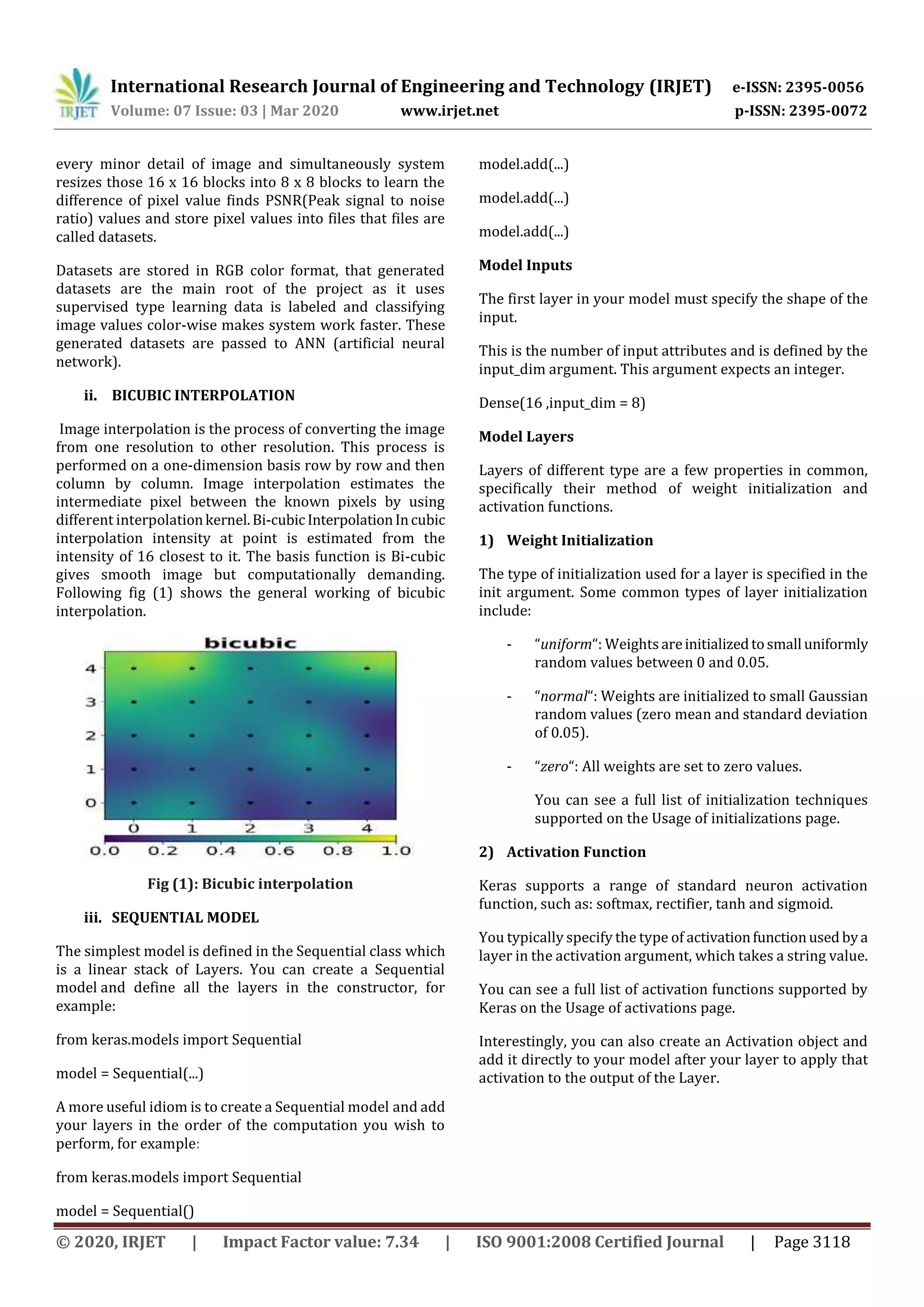This document discusses using machine learning for single image super resolution. It presents an algorithm that takes a low resolution image as input and produces a high resolution output image. It uses a Fastest Artificial Neural Network (FANN) to map low and high resolutions. Pixels are analyzed and datasets with noise errors are created and used to train the neural network. The network learns to reduce noise and errors to generate a high quality output image. It is useful for applications like medical imaging, surveillance and crime investigation.


![International Research Journal of Engineering and Technology (IRJET) e-ISSN: 2395-0056 Volume: 07 Issue: 03 | Mar 2020 www.irjet.net p-ISSN: 2395-0072 © 2020, IRJET | Impact Factor value: 7.34 | ISO 9001:2008 Certified Journal | Page 3119 3) Layer Types There are large number of core Layer typesforstandard neural networks. Some common and useful layer types you can choose from are: Dense: Fully connectedlayerandthemostcommon type of layer used on multi-layer perceptron models. Dropout: Apply dropout to the model, setting a fraction of inputs to zero to reduce over fitting. Merge: Combine the inputs from multiple models into a single model. You can learn about the full list of core Keras layers on the Core Layers page Model Compilation Once you have defined your model, it needs to be compiled. This creates the efficient structures used by the underlying backend (Theano or TensorFlow) in order to efficiently execute your model during training. You compile your model using the compile() function and it accepts three important attributes: 1. Model optimizer. 2. Loss function. 3. Metrics. model.compile(optimizer=, loss=, metrics=) Model Prediction Once you have trained your model, you can use it to make predictions on test data or new data. There are number of different outputtypesyoucancalculate from your trained model, each calculated using a different function call on your model object. For example: model.evaluate(): To calculate the loss values for input data. model.predict(): To generate network output for input data. model.predict_classes(): To generate class outputs for input data. model.predict_proba(): To generate class probabilities for input data Summarize the Model Once you are happy with your model you can finalize it. You may wish to output a summary of your model. For example, you can display a summary of a model by calling the summary function, for example : Model.summary() IV. RESULT V. CONCLUSIONS 1. We have constructed a deep neural network to process and enhance quality of images .The major advantage of the super resolutionapproachisthatit may cost less and the existing LR imaging systems can be still utilized. 2. Synthetic zooming of region of interest (ROI) is another important application surveillance, forensic, scientific, medical, and satellite imaging. 3. This application is most suitable for magnifying objects in the scene such as the face of a criminal or the license plate of a car. VI. ACKNOWLEDGEMENT This research was supported by BMIT collegeof engineering Solapur. We are thankful to our guide Prof. Asiya Khan who provided her expertise in Machine Learning area that greatly assisted to perform the research. VII. REFERENCES [1] https://ieeexplore.ieee.org/document/7802119 [2] https://ieeexplore.ieee.org/document/5459271 [3] https://medium.com/@birla.deepak26/single-image- super-resolution-using-gans-keras-aca310f33112 [4] https://medium.com/@jonathan_hui/gan-super- resolution-gan-srgan-b471da7270ec](https://image.slidesharecdn.com/irjet-v7i3624-201226130544/75/IRJET-Single-Image-Super-Resolution-using-Machine-Learning-3-2048.jpg)